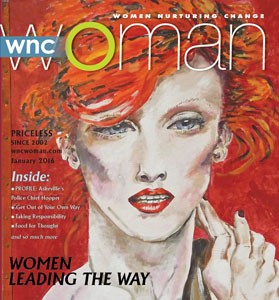Reviewed by Mary Ickes
As the author’s faithful canine companion and writing coach, Bucky Restivo remains ever on alert at his post beneath her desk, and writerly expletives rend the air, he knows that she requires his assistance. Therefore, Bucky volunteered to pen Jeanne’s “Funny, Isn’t It?” column for the October WNC Woman Magazine. Lest he give too much away, Bucky succinctly states that Shanty Gold relates the fictitious story of Mary Boland, Jeanne’s great-great grandmother, emigrating from Ireland.
As her story opens, Mary is walking thirty miles from her village of Kinsale to the port city of Queenstown where she hopes to board a ship bound for America. She carries no possessions, but the burden of guilt for losing her mother and baby sister to starvation almost overwhelms her. With no other options available, Mary boards the Pilgrims Dandy, a coffin ship. (Owners of coffin ships charged cheaper rates for ships barely still afloat and supplied, if any at all, less food and water than required by law. A mortality rate of 30%, as on the Pilgrims Dandy, was the norm.) Mary is so traumatized that she considers jumping overboard until befriended by Kamua, a slave boy. He hides and protects her until the Pilgrims Dandy sails in to Boston Harbor eleven weeks later. Mary and Kamua declare themselves brother and sister of the spirit and vow to help each other succeed.
Mary, though illiterate, soon learns that N.I.N.A. posted in a store window means No Irish Need Apply. After twelve days of desperate searching, Kathleen O’Halloran hires Mary to work in the pub owned by her and Tommy, her husband. Kathleen, the story’s moral compass, befriends and protects Mary and Kamua and teaches them to read and write. As they explore new ideas and ponder destinies beyond their initial expectations, their lives in America begin anew. Mary wonders, Besides finding Da, what is me destiny? I love working at O’Halloran’s, but I can do more.
Because Mary and Kamua are so young, their successes stretch the reader’s credibility; when their story opens in 1849, she is age thirteen and he is fifteen. Like many immigrants before and after them, Mary and Kamua were a new breed of young people with boldness, audacity, and nothing more to lose. Mary and Kamua lost their families to greedy violence, suffered horrifically on the Pilgrims Dandy, and arrived in Boston owning only the rags they wore. By the book’s end in 1852, Mary has progressed from a girl with barely enough strength to walk from Kinsale to Queenstown into a young woman with a destiny that will correct injustices that poor women endure.
Mary, a discerning narrator, provides readers with an acute sense of place whether in desolate Ireland, in the Pilgrims Dandy’s deadly hold, or on Boston’s churning streets. She and Kamua, accustomed to lack, are happily … ‘distracted with all the wares offered along the road. There are shoes for human feet and horse hooves … and chamber pots so fancy they look like soup urns.’ She scorns a rich person’s home… ‘If the foyer is gaudy, the drawing room can be described as nothing but shanty-Irish brash.’ Mary misses nothing and duly informs her reader.
She has learned to be equally perceptive about people… ‘Now, I have faith in me instincts. They are sharp. Mary Boland is no longer the fool girl who trusted’ … She befriends Stash, the kindly oarsman who rows them to shore, but she is rightly terrified by Shiv McGraw at first glance. Daniel Kelly might be Adonis handsome and smitten with her, but Mary insists on a successful career first, romance second. With each appearance, the main characters grow in complexity and interest.
Jeanne Charters’ meticulous research in Ireland and Boston makes Shanty Gold a historical novel suitable for mature young adults, their parents, and grandparents, no matter what their level of expertise on Ireland’s Great Famine and the ensuing emigration.
Jeanne notes in her November “Funny, Isn’t It?” that an Amazon reviewer wrote, “Good Story, fair brogue.” For the many readers, including me, who would probably stop reading a book rather than slog through a full brogue, Mary’s lilting Irish is a relief.
As you will see in the author’s bio, Shanty Gold is the first book in a trilogy about women fleeing the Irish Famine. Bucky has assured me that he is supervising Jeanne as she writes Lace Curtain to make sure that she continues the high standards of historical accuracy and reading enjoyment established in Shanty Gold.
Author Bio: After her release from prison (corporate business), Jeanne Charters vowed to reform, so she quit her criminal life (not really) and started writing for WNC Woman. You, too, can find redemption! Write a book…or buy Shanty Gold or both! www.jeannecharters.com
Just kidding! Jeanne Charters is a historical fiction author who plans to follow her debut novel, Shanty Gold, with two more books based on female Irish immigrants’ experiences in coming to America. Lace Curtain and Silk Stockings will be published in 2016 and 2017 by Rogue Phoenix Press.
In this Irish-American trilogy, Jeanne’s heroines, Mary Boland, Nellie Kelly, and Kate O’Halloran inherit brutal circumstances emanating from the mid-nineteenth century Irish Famine. Their converging stories culminate in a most dramatic ending, and, for two, a new beginning.
Jeanne, former President of Charters Marketing, an award-winning advertising agency based in New York State, now lives in Asheville, North Carolina, with her husband, Matt Restivo and therapy dog, Bucky. She is published by Rogue Phoenix Press www.roguephoenixpress.com represented by Loiacono Literary Agency www.loiaconoliteraryagency.com . Shanty Gold is available in Asheville at Malaprops and Mountain Made; in Brevard, at Highland Books; in Waynesville, at Blue Ridge Books and News; and in Tryon at the Book Shelf. And, of course, on Amazon B&N KOBO GoodReads Shelfari IDreamBooks Scribd .

